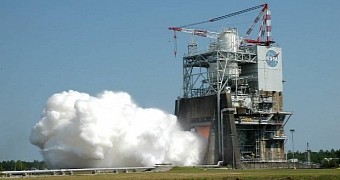NASA is now hard at work building the most powerful rocket the world has ever seen, the Space Launch System. The agency expects the rocket, designed to launch astronauts to Mars, will be assembled by 2018 at the latest.
This August 14, NASA came one step closer to wrapping up work on its Space Launch System when it tested one of the rocket's four engines at the Stennis Space Center near Bay St. Louis, Mississippi.
The RS-25 engine, mounted on a ring for this test, was fired up for a total of 535 seconds, which is precisely the amount of time it would need to keep up and running during an actual successful launch.
NASA scientists are now sifting through the data collected during this latest run, looking at how the next-generation engine performed at different thrust levels. Software performance and flow of propellant are also under scrutiny.
Four such engines will power the Space Launch System
When completed at long last, the Space Launch System will be fitted with four such engines. Together, the engines should deliver astronauts further into orbit than any other launch vehicle so far developed. Then, the Orion spacecraft will carry the crew further into space.
“SLS [Space Launch System] will launch astronauts in the Orion spacecraft on missions to deep space and eventually on the journey to Mars,” NASA explains.
“An initial 70-metric-ton (77-ton) SLS configuration will use four RS-25 engines for the core stage, along with two five-segment solid rocket boosters, providing more lift to orbit than any current launch vehicle,” the agency goes on to detail.
NASA plans to put the RS-25 engine through one more individual test before coupling four of them to simulate an actual launch of its Mars-bound rocket.
Then, sometime in 2018, when the Space Launch System is ready to take to the skies, it will be sent on its maiden voyage to space together with Orion. This planned 7-day mission, i.e. Exploration Mission 1, will see Orion journey around the Moon.

 14 DAY TRIAL //
14 DAY TRIAL // 